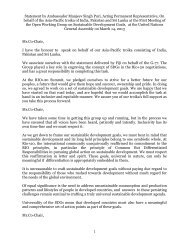STATE OF THE WORLD'S CITIES 2012/2013 Prosperity
STATE OF THE WORLD'S CITIES 2012/2013 Prosperity
STATE OF THE WORLD'S CITIES 2012/2013 Prosperity
Create successful ePaper yourself
Turn your PDF publications into a flip-book with our unique Google optimized e-Paper software.
exceptions, modern urban planning has failed to integrate<br />
the urban poor in the socioeconomic fabric of the city.<br />
As an expert in Bangalore put it, “The poor have survived<br />
despite master planning.” 30 Understood primarily as a<br />
technical tool, planning has been unable to address the<br />
power relations that have been at work to the detriment of<br />
the great majorities of urban populations. Planning has also<br />
proved unable to prevent environmental degradation or the<br />
formation of slums, and is notable for serious shortcomings<br />
in terms of transport and urban mobility.<br />
Conceived as a comprehensive, long-term strategy,<br />
a master plan – the quintessence of modern planning –<br />
typically represents an ideal end-state for a particular city<br />
with serious gaps between the initial vision and actual<br />
results. This has ensued in what a scholar in 1996 called<br />
“the dark side of planning” 31 , something an expert in<br />
Montevideo has referred to as “urban plans that are at odds<br />
with the notion of prosperity.” 32<br />
The shortcomings of modern urban planning have<br />
triggered significant reform since the 1980s and 1990s, in an<br />
effort to move away from comprehensive plans, top-down<br />
decision-making and wide-ranging regulation. 33 A more<br />
flexible approach was adopted to improve conditions in<br />
cities, through ‘strategic planning’ and other methods that<br />
are more pragmatic, incremental and typically focused on<br />
‘getting things done’. However, too many ‘strategic urban<br />
plans’ have effectively imposed an entrepreneurial view of<br />
the city, promoting mostly economic prosperity and often<br />
turning into marketing gimmicks in all but name, complete<br />
with oversized architectural designs and mega-developments.<br />
In emerging or developing countries, these initiatives<br />
typically favour the gentrification of entire areas and, at times,<br />
massive displacement in order to make room for highways,<br />
skyscrapers, luxury compounds, shopping malls, etc., at the<br />
expense of the habitat and livelihoods of the poor. 34<br />
UN-Habitat policy analysis in 50 cities in Asia, Africa,<br />
Latin America and the Arab States (2011) shows that up<br />
to 80 per cent of local<br />
experts believe that the<br />
benefits of economic<br />
FACT prosperity mainly serve the<br />
interests of the wealthy and<br />
politicians (a view shared<br />
by up to 90 per cent of<br />
African experts). Through<br />
political influence, bribery<br />
and corruption, these<br />
powerful interest groups<br />
Whatever<br />
the planning<br />
approach, powerful<br />
political and economic<br />
interests keep interfering<br />
with the design and<br />
implementation of<br />
strategic plans and<br />
the pursuit of urban<br />
prosperity for all.<br />
Innovating to Support the Transition to the City of the 21st Century<br />
109<br />
FACT<br />
From Asia to Africa to Latin America, ‘master’,<br />
‘blueprint’ and layout plans have had similar,<br />
harmful consequences in countless numbers of cities: spatial<br />
segregation, social exclusion, excessive mobility needs and<br />
consumption of energy, together with poor regard for the<br />
potential economies of scale and agglomeration that any city<br />
can offer. 29<br />
manage to distort urban plans, dodge spatial or legal rules,<br />
reduce the production of public goods and manipulate<br />
the power of eminent domain; in the process they<br />
capture unfair shares of a city’s potential, resources and<br />
prosperity to the detriment of large, poor majorities of<br />
urban populations.<br />
The New Urbanism Movement of the early 1980s<br />
broke with conventional master-planning and introduced<br />
a number of welcome innovations: liveable, pedestrianfriendly<br />
cities, dense neighbourhoods with mixes of<br />
housing and job-creating commercial and business sites,<br />
together with mixed land uses having a diversity of<br />
buildings in terms of style, size, price and function – all<br />
of this with a strong focus on local communities. 35 For all<br />
these fresh efforts, though, a conventional approach to<br />
urban development has remained dominant to this day.<br />
In developing and emerging countries alike, cities are still<br />
hostages to a mix of homogeneous forms or functions on<br />
the one hand, and spatial /social segregation on the other<br />
hand. Urban areas continue to expand across endless<br />
peripheries, with serious, pervasive problems of traffic<br />
congestion, enhancing the dependence on motor vehicles<br />
and intensive use of expensive fossil fuels. This dominant<br />
type of city is detrimental to the built heritage and the<br />
environment, including<br />
surrounding agricultural<br />
land, as well as biodiversity.<br />
This is the pattern which<br />
UN-Habitat refers to as<br />
the “Global Standard<br />
Urbanization Model<br />
of the 20th Century”<br />
(GS20C), 36 Today, the<br />
FACT GS20C<br />
model appears to be<br />
predominant across<br />
the world, being<br />
largely driven by land<br />
which<br />
speculation and real<br />
estate interests that<br />
privileges individualism,<br />
build cities according to<br />
consumerism, new<br />
financial and economic<br />
(artificial) values and<br />
parameters often<br />
lifestyles, excessive mobility radically at odds with<br />
and privatization of the<br />
shared prosperity.<br />
public space.<br />
37




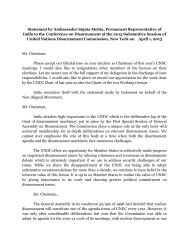
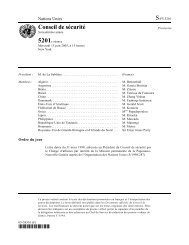
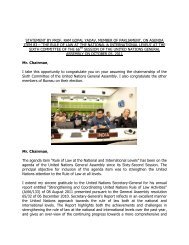
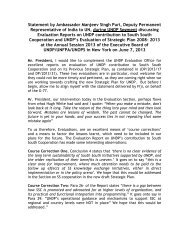
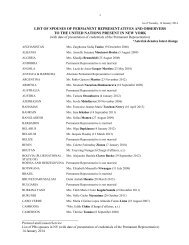
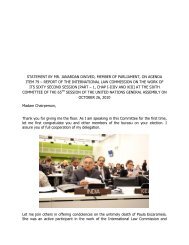
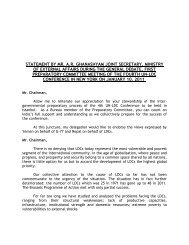
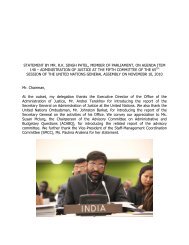

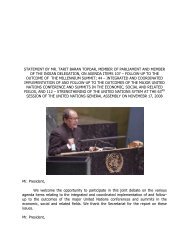
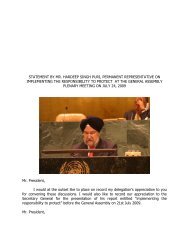
![1 statement by dr.[mrs] kakoli ghosh dastidar - Member States Portal](https://img.yumpu.com/27526598/1/190x245/1-statement-by-drmrs-kakoli-ghosh-dastidar-member-states-portal.jpg?quality=85)
